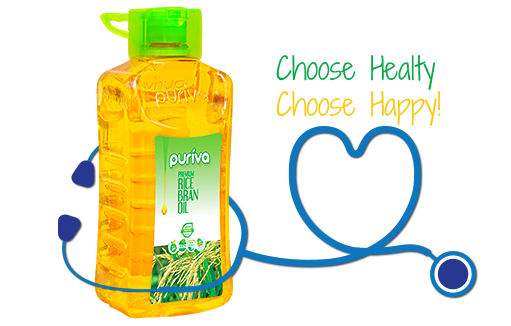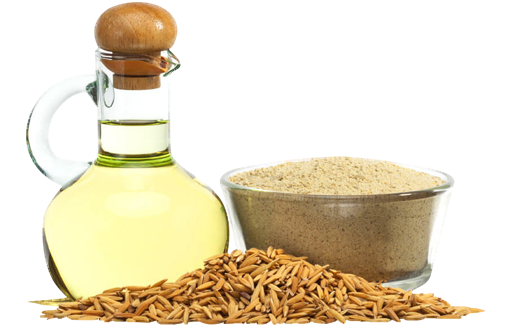

From the paddy first the husk of the rice grain is removed, resulting in a brown rice grain. The brown bran layer and rice germ are then removed leaving behind a white rice grain. The bran fraction, which includes the germ or embryo in most commercial milling operations, represents only about 8% of paddy weight but contains about three-fourths of the total oil (Juliano and Bechtel, 1985; Lu and Luh, 1991). Containing about 18-22% oil.
Rice Bran Oil is first extracted from the bran and germ. The oil is then refined and separated into a clear liquid and hard fraction.

Rice bran oil has a unique fatty acid profile that makes it the most balanced and versatile vegetable oil available on earth. Compared to other oils like olive oil, rice bran oil has a much higher smoke point. This smoke point makes rice bran oil very suitable for deep-frying, stir-frying or just regular cooking. When oil is heated above its smoke point, harmful matter is released. There is also a loss in flavour. Rice bran oil, having a very high smoke point, is much healthier than other oils when cooking with high temperatures.
The common usage of Rice Bran Oil includes-
Cooking
Deep Frying
Stir-Frying
Snacks
Margarine
Salad Dressing
Backing
Cosmetics
Pharmaceuticals

 Rice Bran Oil
Rice Bran Oil Puriva Rice Bran Oil exerts hypocholesterolemic activity in relation to more commonly used vegetable oils and is characterized by a relatively high content of non-fatty acid components known to have beneficial health effects.
Naturally rich in Vitamin E (Tocopherols and Tocotrienols). Tocopherols protects human body from ailments and maintains the balance of nervous system. Tocotrienols are known to have anti-cancer, anti-thrombotic and anti-ageing properties.
Substantial Oryzanol presence. A powerful antioxidant found only in RBO, it is more effective than Vitamin E in fighting free radicals, lowering the blood cholesterol level, reducing the liver cholesterol synthesis and treating menopausal disorders. Not to mention the anti-itching, anti-dandruff and anti ageing properties.
High levels of Mono Unsaturated Fatty Acid (MUFA) to lower the LDL-C, the bad cholesterol and increase the HDL-C, the good cholesterol.
Absorbs upto 20-30% less into food hence reduces the calorie intake.
High oxidative stability when compared to other soft oils due to the presence of natural anti-oxidants like Vitamin E and Oryzanol.
Rice Bran Oil reduces the chances of Coronary Heart Diseases.


Puriva Rice bran oil is a superior cooking oil which leaves no lingering aftertaste. The high smoke point prevents fatty acid breakdown at high temperatures and makes the oil usable even after multiple frying. Its light nature allows less oil to be absorbed into food while cooking, reducing overall calories. It mixes better in salad dressings and improves the taste of baked goods providing cholesterol reduction, nutritional and anti-oxidant value. A hypoallergenic, it is also very good for those who have intolerance to other cooking oils.
Benefits of Rice Bran Oil at a glance
1. Oryzanol-reduce bad cholesterol, improve good cholesterol, healthier heart.
2. Tocotreinols, & Phytosterois-Anti-cancer properties.
3. Natural Anti-oxidant-Keep younger, protect against diseases.
4. Vitamin E- Help maintaining balance of nervous system.
5. Ferulic Acid- Rejuvenation, stimulate hormonal secretion.
6. PUFA/MUFA- Balance ratios help to clean blood vessel.
7. Squalene-Improve skin tone and condition.
8. Balance Fatty Acid-Balance nutrition means balance health.
9. Low Oil Absorption- Healthier oil.
10. Light Favour.
11. High Smoke Point- Ideal for deep frying, cooking, grill and baking.
Source: Joint FAO/WHO food standard programme. Codex Committee On Fats and Oils, 18th Session, UK, 3-7th February 2003.
Nearest to WHO recommendation.
| Oil Type | Smoke Point | Mono Unsaturated Fat | Poly Unsaturated Fat | Unsaturated Fat |
|---|---|---|---|---|
| Rice Bran Oil | 490º | 47% | 33% | 20% |
| Olive | 360º | 77% | 9% | 14% |
| Canola | 450º | 61% | 33% | 7% |
| Peanut | 460º | 48% | 34% | 18% |
| Soybean | 440º | 24% | 61% | 15% |
| Grape seed | 485º | 14% | 77% | 9% |
Olive Oil High mono fat, able to lower cholesterol but deficient in poly fat, which contains Essential Fatty Acids (EFA). EFA’s are truly essential to life as every metabolic process in your body depends on them. A low smoke point makes it a poor choice for frying, and its heavy taste makes it undesirable in many baked goods. Traditionally a good salad oil.
Canola Oil High mono fat with cholesterol lowering ability but there are concerns about the origin. “Canola oil” is a term coined by Canada to change the name of “rapeseed oil”. The rapeseed plant contains erucic acid making it toxic and is used as an industrial lubricant. It has been genetically modified and hybrid to produce a low erucic acid version. Commonly hydrogenated, it is extensively used in the food industry because of its low price. The hybrid plant would be the best choice.
Peanut Oil A good balanced oil. This oil has good cholesterol lowering ability and a high smoke point, making it a good frying oil. It imparts a slightly earthy, nutty flavor. It lacks the anti-oxidants and micronutrients of Rice Bran Oil. A small percentage of people are allergic to nut oils.
Soybean Oil This oil is a high poly fat. As recommended by the AHA your poly fat intake should be around 33% of your total fat intake. A high poly percentage is, an aid to tumors and cancer and should be carefully watched. Up to 80% of the oil consumed in the U.S.A. today comes from soybeans. Soybean oil is commonly hydrogenated and used in many processed foods.ow smoke point makes it a poor choice for frying, and its heavy taste makes it undesirable in many baked goods. Traditionally a good salad oil.
Grape Seed Oil A good frying and salad oil, but again high in poly fat. It does lower cholesterol because of the high unsaturated fat content but is way over the recommended 33% poly-unsaturated fat.
Rice Bran Oil The most balanced and versatile oil on the market and closest to the AHA recommendations. Rice bran oil is a superior salad, cooking, and frying oil which leaves no lingering after taste. The high smoke point prevents fatty acid breakdown at high temperatures.
| Oil Type | Vitamin E Tocopherol (ppm*) | Vitamin E Tocotrienol (ppm*) | Oryzanol (ppm*) | Total Natural Antioxidants (ppm*) |
|---|---|---|---|---|
| Rice Bran Oil | 81 | 336 | 2,000 | 2,417 |
| Olive | 51 | 0 | 0 | 51 |
| Canola | 650 | 0 | 0 | 650 |
| Peanut | 487 | 0 | 0 | 487 |
| Soybean | 1,000 | 0 | 0 | 1,000 |
| Grape seed | 256 | 149 | 0 | 405 |
High in Oryzanol is a powerful antioxidant only found in rice bran oil. It is more active than Vitamin E in fighting free radicals. Oryzanol is effective in lowering cholesterol levels in the blood, reducing liver cholesterol synthesis and treating menopausal disorders.
Phytosterols (not shown in the antioxidant chart) are nutrients with many health benefits and are more abundant in Rice Bran Oil than any other oil. Scientific research suggest that Phytosterols reduce cholesterol, provide anti-inflammatory effects, inhibit the growth of cancer cells, improve the immune system and have other health benefits. There are 27 different phytosterols in Rice Bran Oil.
Being globally recognized as the true “Health Oil” Puriva Rice Bran Oil stands in a class by itself because of its surprisingly good performance and health benefits.